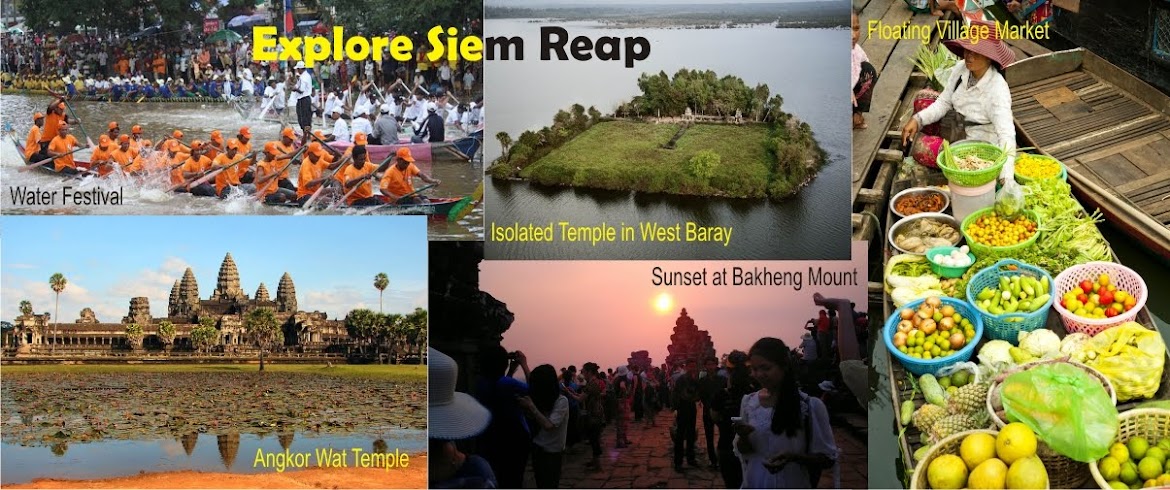Historic Procession (over 100 m long)
This relief deals with King Suryavarman II, whose posthumous name is Paramavishnuloka (3, page 11). In the upper register we can see the solemn audience granted by the king, seated on a richly decorated throne. He has a graceful natural pose, but not without nobility, and gives instructions to personages seated nearby. All around are advisers or religious people, and soldiers respectfully grouped. The rank of the king is demonstrated by the 14 parasols required by protocol, complementing the fly-whisks.
In recent times, the crowds of visitors to the temple have covered the image of the King with gold leaf, in an act of respect and veneration. In contrast, the demonic and hateful figures have been dirtied by the betel spittle of the visitors.
Amongst the group surrounding the king, one can see a Brahmin priest, recognisable by his high chignon (152). One of the main state ministers (153), whose rank is show by his slightly larger size, sits in front, but turns his head towards the king, his right arm on his heart, a typical pose of loyalty and obedience.
In the lower registers there is a parade of the queens, princesses and ladies of the court (154).
The highest ranking ones are carried in hammocks or palanquins covered with a canopy; attending them are the servants and slaves. They go through a forest inhabited by deer, and pick fruit from trees enlivened by many birds (111,page 81).
In the second part of the relief, the soldiers descend from the mountain and the infantry parades in marching order, escorting the generals and high dignitaries mounted on elephants.
There are 21 main figures in the procession: the king himself, and his Rajahota, plus his 19 ministers whose names and titles are inscribed below them on the relief. Each has the appropriate number of parasols for his rand. The generals and dignitaries are standing on their elephants in poses full of nobility, their left foot on the war saddle, and their right on the croup of the animal; they carry a spear and hold a large leather shield for protection. The mahout who guides the animal, sits on his neck(91, page 67). The generals, like the infantry, have their lower body clothed in a sampot, whose long tails hang down from the belt to gather on the side. The soldiers have helmets decorated with an animal head, and carry round shields (153). The horses of the chiefs are sculpted in great detail (155). In many cases; the king (156) and the generals are conspicuously holding a phak, the characteristic long-handled club. This instrument (never seen in use by ordinary people on the Bayon reliefs) is still used nowadays in Cambodia. India. The parade continues, in a rather monotonous way. The soldiers at the end of the column are shown accelerating their march by lengthening their steps in order to catch up with those ahead who are marching in step.
In an evident attempt to introduce some diversion into the stereotyped poses, repeated many times, the sculptors have included some amusing details: the elephant of one of the generals, perhaps stung by an insect, suddenly turns his head in a menacing way towards the observer. Towards the three-quarter point of the panel, an interruption occurs in the military parade, to give way to a cortege of priests: Brahmins with high chignons, playing small bells. The Rajahota, or royal priest, is carried on a hammock(157), just like the abbot of a pagoda nowadays. The ark follows, containing the sacred fire, and escorting the army to sanctify the battle and attract the attention of the gods. Numerous porters are preceded by trumpeters, drummers, conch players, and an enormous gong beaten with a large mallet. In this group, there are also two clowns dancing in a grotesque way and some banner-carriers juggling with their insignia. The same clowns accompany religious processions in present-day Cambodia. At the end of the panel, a group of unusual people appears, with extravagant costumes, long vests with pendants, bizarre hair styles with three or four plumes and five rows of superimposed beads. The general is covered with bracelets and necklaces, plus many other decorative elements (158). The soldiers are tattooed under the cheek and have an uncouth physiognomy. Fortunately, an inscription solves the enigma:”They are the Siamese”, perhaps incorporated into the Khmer army.

No comments:
Post a Comment